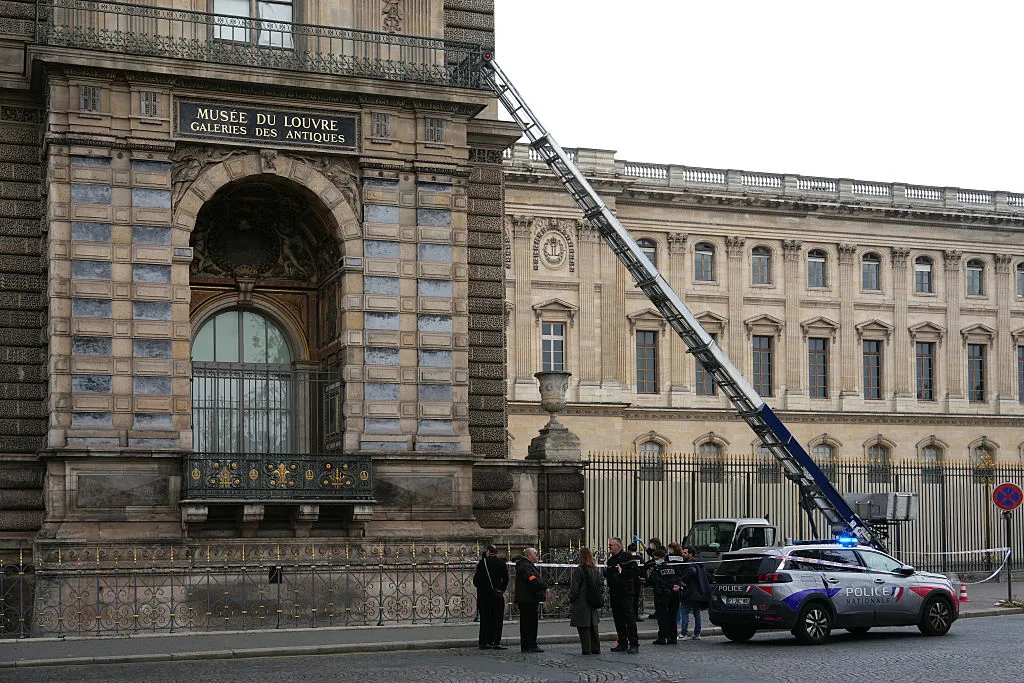In what security experts are calling one of the most sophisticated museum heists in modern history, thieves executed a daring and meticulously planned operation to steal a collection of “priceless” royal jewels from a secured exhibition area of the Louvre Museum in Paris. The robbery, which took place in the early morning hours before the museum opened to the public, has sent shockwaves through the art and security world—not only because of the value of the stolen treasure but because of the flawless precision of the crime.
Authorities believe the theft was carried out by a professional team with high-level expertise in museum security systems, alarm bypass technology, and international smuggling networks. The daring heist has raised an uncomfortable question: If even the Louvre—the world’s most secure museum—can be robbed, what collection is truly safe?
The Target: Royal Treasure on Temporary Display
The stolen jewels were part of a temporary exhibition titled French Elegance: Masterpieces of Royal Jewelry, featuring historical gems from the House of Bourbon, Napoleonic era, and French aristocracy prior to the Revolution. Among the missing pieces are:
- A diamond-encrusted tiara belonging to Empress Eugénie, wife of Napoleon III
- The Sancy Diamond replica, once part of the French Crown Jewels
- An 18th-century ruby and diamond brooch crafted by royal jeweler Jacques Chaumet
- A pair of sapphire earrings formerly owned by the Duchess of Angoulême
While officials have yet to release an official valuation, experts estimate the jewels could be worth between €120 million and €200 million on the black market—though their historical significance makes them effectively priceless.
The Heist Timeline: 18 Minutes of Perfection
French security officials released a preliminary reconstruction of the timeline:
| Time | Event |
|---|---|
| 2:37 AM | Louvre’s external cameras detect power fluctuation near service wing |
| 2:39 AM | Thieves enter via rooftop skylight using thermal drills |
| 2:41 AM | Internal motion detectors disabled by signal jammer |
| 2:46 AM | Exhibition display cases breached with diamond-tipped micro tools |
| 2:52 AM | Jewels extracted and stashed in lead-lined cases |
| 2:55 AM | Thieves exit through underground maintenance tunnel |
| 2:57 AM | Museum security receives first silent alarm irregularity |
| 3:05 AM | Police arrive—thieves already gone |
The entire operation took less than 20 minutes.
How They Did It: A Crime of Engineering
Police investigators have noted three key elements that suggest a top-tier criminal operation:
1. High-Level Surveillance Intelligence
The thieves seemed to know:
- Camera blind spots
- Security rotation shifts
- Locations of silent alarms and motion sensors
Investigators suspect inside help or prior access through maintenance contractors.
2. Military-Grade Signal Jammers
Instead of hacking Louvre systems, the thieves jammed alarm signals, preventing real-time notification to police. This tactic is rare outside of nation-level operations or elite crime syndicates.
3. Exit Through Historical Tunnel System
Forensic teams discovered the thieves escaped through a sealed 19th-century service tunnel—part of the old medieval Louvre fortress beneath the museum. This access was unknown even to some current museum staff.
Who Is Behind the Theft?
French investigators are focusing on three prime suspects:
| Group | Description |
|---|---|
| Pink Panthers | Balkan-based jewel theft syndicate known for high-speed operations |
| Russian Art Mafia | Linked to museum heists in Germany and Scandinavia |
| Private Collector Ring | Operates through black-market intermediaries to acquire stolen artifacts |
Interpol has already issued a Red Notice for unidentified suspects, suggesting evidence points to an international operation. Meanwhile, the Louvre’s insurers are treating this as “a premeditated precision theft by elite professionals.”
Why the Jewels May Never Be Seen Again
Art crime experts warn that the jewels may already be disassembled. Thieves typically remove stones from historic jewelry to erase identifying characteristics, making recovery nearly impossible. Some pieces may end up in Dubai, Hong Kong, or Istanbul, known transit hubs for illicit luxury goods.
Jean-Pierre Valois, a former investigator with the French Ministry of Culture, said:
“This was not a smash-and-grab robbery. It was a surgical extraction. Whoever did this had a buyer ready before they stepped into the Louvre.”
Security Failure or Inside Job?
The French Minister of the Interior has ordered a full review of museum security protocols across all national institutions. Early reports suggest:
- Louvre alarm system logs were tampered with
- A staff security badge was cloned
- The thieves used access codes issued within 24 hours of the crime
These findings have fueled speculation of inside involvement—possibly corruption, coercion, or blackmail.
The Mystery Deepens
The Louvre has temporarily closed part of its Richelieu Wing during the investigation. The museum’s director, Isabelle Marchand, called the robbery “an attack on humanity’s cultural heritage.”
Shockwaves from the heist have reached beyond France, reigniting global concern over the growing $6-billion-per-year black market in stolen art and antiquities.
Final Word: A Perfect Crime—For Now
The Louvre heist is already being compared to legendary robberies like the Isabella Stewart Gardner Museum theft of 1990 and the Dresden Green Vault burglary of 2019. Whether these jewels are ever recovered—or disappear into private vaults forever—may depend on a global hunt already underway.
For now, the jewel thieves have melted away into the shadows, leaving only questions behind. How did they get in? Who helped them? And most unsettling of all—will they strike again?






















